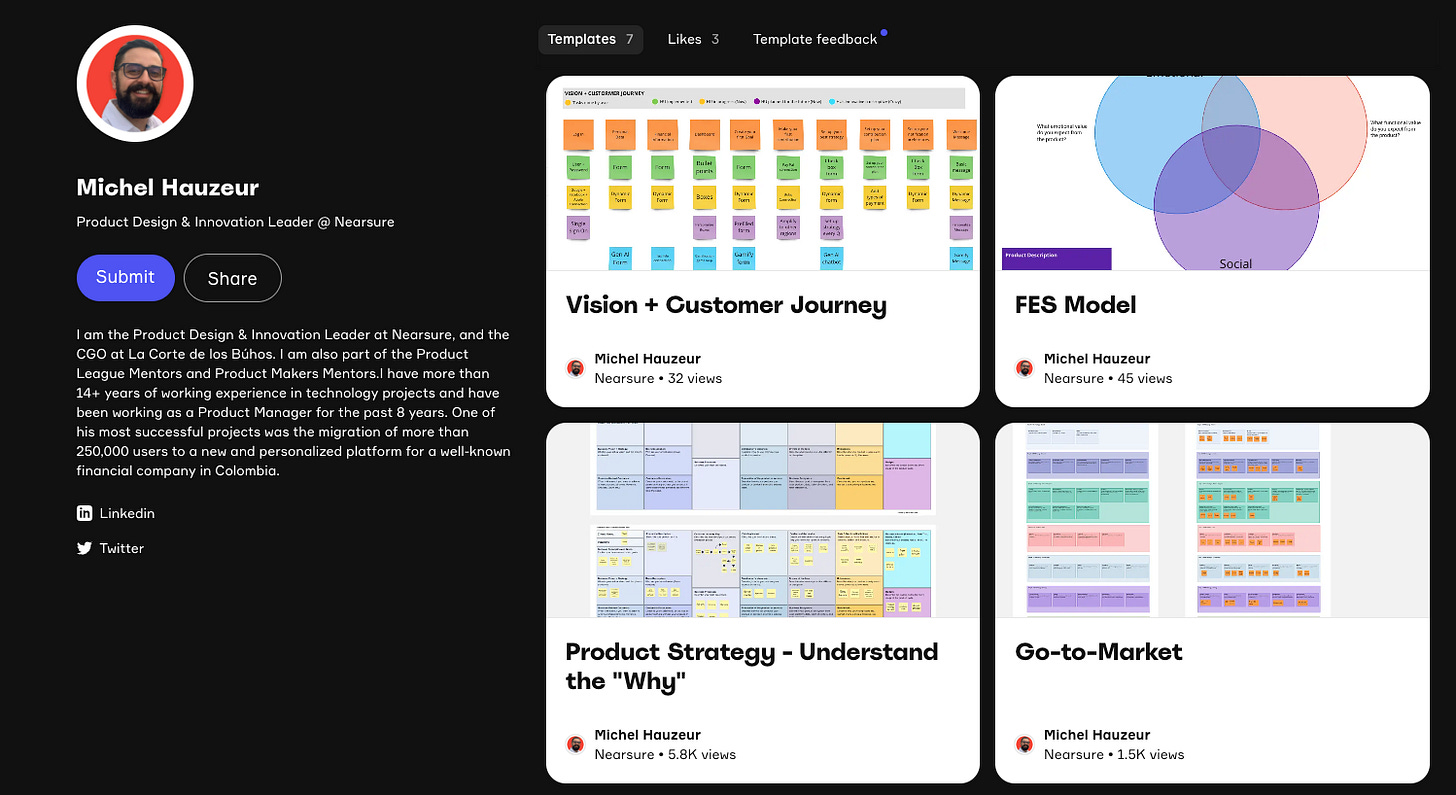What is my ideal Career Path for Product Managers - Chapter 3
This is a three chapter journey where we will talk about Product Management Career Path.
Hi readers, it is Michel Hauzeur again!
Currently Co-founder of La corte de los Búhos, a Growth consulting company in Latam focusing on Product Growth, Positioning, and Team Growth.
And 2023 Product-Led Alliance Award as Product Leader of the Year winner.
These are the three chapters:
Chapter 3: How to apply this framework (This Chapter)
Chapter 4: Soft Skills
Chapter 3 - How to apply this framework
Section 1: The Career Path Skills
In my second chapter, 'What is my ideal Career Path for Product Managers?', I explore the essential skills that product managers need at various stages of their careers.
Here are the five most important insights from this chapter:
Skill Evolution: I emphasize how these skills evolve and become more strategic as product manager advance in their career. This progression aligns with the growth path from Product Development to Product Growth.
A Holistic Approach: I stress the importance of developing a well-rounded skill set covering technical and interpersonal aspects of product management.
Continuous Learning: Throughout the chapter, I highlight the need for ongoing skill development and adaptation in the ever-changing field of product management.
Practical Application: I analyze each skill based on its importance and application across the product management lifecycle, providing practical insights for readers.
Career Advancement: By mastering these skills, I explain how product managers can progress from hands-on development roles to more strategic positions, aligning with the career path framework I introduced in Chapter 1.
This comprehensive breakdown of skills serves as a roadmap for product managers to assess their current abilities and identify areas for growth as they navigate their career paths.
Section 2: Applicability
Product Development
In this phase, it is essential to:
Define Product Requirements: Collaborate with stakeholders to gather and document precise product specifications.
Create a Product Roadmap: Develop a strategic plan outlining key milestones and features.
Prioritize Features: Use techniques like MoSCoW or weighted scoring to determine feature priorities.
Design User Stories: Break down features into actionable user stories with clear acceptance criteria.
Plan Sprints: Organize development work into manageable sprints, typically 1-2 weeks long.
Facilitate Development: Work closely with the development team, removing obstacles and clarifying requirements.
Conduct Regular Reviews: Hold sprint reviews to demonstrate progress and gather feedback.
Manage the Backlog: Continuously refine and reprioritize the product backlog based on new insights and feedback.
Implement Quality Assurance: Ensure thorough testing and bug fixing throughout development.
Prepare for Launch: Coordinate with marketing, sales, and support teams to prepare for product release.
Skills put it in place:
Product Orientation: Understanding the product lifecycle, development processes, and relevant tools and frameworks to guide effective product creation.
Business Knowledge & Orientation: Grasping market dynamics, customer needs, and business goals to inform product development decisions.
Management: Developing roadmapping, sprint planning, and stakeholder management skills to oversee development timelines and deliverables.
Facilitation: Leading cross-functional teams, managing stakeholders, and driving collaborative product development processes.
Tech Knowledge: Understanding development processes, technical constraints, and emerging technologies to communicate effectively with engineering teams.
Human Centric: Focusing on user needs and experiences to ensure the product meets user expectations and solves real problems.
Product Marketing and Growth: Considering future growth potential and marketing aspects in early development stages to support long-term product success.
Pattern of Thinking: Applying analytical and strategic thinking to identify trends, solve problems, and make data-driven decisions during product development.
Creativity: Generating innovative solutions to product challenges and thinking outside the box for feature development.
Agile Methodologies: Implementing iterative development processes to ensure flexibility and rapid product iterations.
Data & AI: Leveraging data analytics and AI tools to inform product features, user experience, and development priorities.
Product Design Phase
In this phase, it is essential to:
Define User Needs: Conduct thorough user research to understand pain points and desires.
Ideate Solutions: Brainstorm innovative ideas to address user needs.
Create Prototypes: Develop low and high-fidelity prototypes to visualize solutions.
Test and Iterate: Conduct user testing and refine designs based on feedback.
Collaborate with Stakeholders: Work closely with engineering, marketing, and other teams to ensure feasibility and alignment.
Skills put it in place:
Product Orientation: Understanding the product lifecycle, tools, and frameworks to effectively guide the design process.
Business Knowledge & Orientation: Aligning designs with business goals and market demands to ensure product viability.
Management: Coordinating design processes, managing resources, and overseeing project timelines.
Facilitation: Leading design workshops, fostering collaborative ideation, and managing stakeholder expectations.
Tech Knowledge: Understanding technical constraints and possibilities to create feasible and innovative designs.
Human Centric: Focusing on user needs, behaviors, and preferences to create intuitive and engaging product experiences.
Product Marketing and Growth: Considering growth potential and marketing aspects in design decisions to support future product success.
Pattern of Thinking: Applying analytical and creative problem-solving skills to address design challenges.
Creativity: Generating innovative design solutions and unique product experiences.
Agile Methodologies: Implementing iterative design processes for rapid prototyping and continuous improvement.
Data & AI: Leveraging data insights and AI capabilities to inform design decisions and enhance user experiences.
Product Strategy Phase
In this phase, it is essential to:
Market Analysis: Conduct thorough research on market trends, competitors, and customer needs.
Vision and Goal Setting: Define a clear product vision and set measurable goals aligned with business objectives.
Opportunity Identification: Identify potential opportunities for product innovation or improvement.
Prioritization: Evaluate and prioritize opportunities based on potential impact and feasibility.
Roadmap Development: Create a strategic product roadmap outlining key milestones and features.
Stakeholder Alignment: Communicate the strategy and gain buy-in from key organizational stakeholders.
Resource Planning: Determine the resources needed to execute the strategy effectively.
KPI Definition: Establish key performance indicators to measure the strategy's success.
Skills put it in place:
Product Orientation: Understanding the product lifecycle, tools, and frameworks to guide strategic decision-making.
Business Knowledge & Orientation: Aligning product strategy with overall business goals and market demands.
Management: Orchestrating the strategy development process and managing stakeholder expectations.
Facilitation: Leading strategy sessions, aligning cross-functional teams, and fostering collaborative decision-making.
Tech Knowledge: Understanding technological trends and capabilities to inform strategic product decisions.
Human Centric: Ensuring the strategy prioritizes user needs and experiences, leading to products that resonate with the target audience.
Product Marketing and Growth: Developing strategies for product positioning, market penetration, and sustainable growth.
Pattern of Thinking: Applying strategic analysis, problem-solving, and identifying innovative opportunities.
Creativity: Driving innovative thinking in strategy formulation, helping to differentiate the product in the market.
Agile Methodologies: Facilitating adaptive planning and iterative strategy refinement based on feedback and changing market conditions.
Data & AI: Leveraging data-driven insights and AI capabilities for predictive modeling and informed strategic decision-making.
Product GTM
In this phase, it is essential to:
Market Research and Segmentation: Conduct in-depth market analysis to identify target segments and understand customer needs.
Positioning and Messaging: Develop a clear value proposition and messaging strategy that resonates with the target audience.
Pricing Strategy: Determine optimal pricing based on market analysis, competitor pricing, and perceived value.
Channel Strategy: Identify and develop appropriate distribution channels for the product.
Marketing Plan: Create a comprehensive marketing plan that includes digital, content, and traditional marketing strategies.
Sales Enablement: Prepare sales teams with the necessary tools, training, and resources.
Launch Planning: Develop a detailed plan with timelines, responsibilities, and success metrics.
Customer Acquisition Strategy: Plan and implement strategies for acquiring early customers and building momentum.
Feedback Loop: Establish mechanisms for gathering and acting on customer feedback post-launch.
Skills put it in place:
Product Orientation: Understanding the product lifecycle, GTM processes, and relevant tools to guide effective launch strategies.
Business Knowledge & Orientation: Aligning GTM strategies with business objectives and market realities.
Management: Coordinating cross-functional teams, managing timelines, and overseeing the complex GTM process.
Facilitation: Leading collaborative sessions, aligning stakeholders, and driving consensus on GTM strategies.
Tech Knowledge: Understanding product capabilities and effectively communicating technical features to different audiences.
Human Centric: Ensuring GTM strategies are focused on addressing real customer needs and pain points.
Product Marketing and Growth: Developing and executing effective promotional strategies, branding, and customer communication.
Pattern of Thinking: Applying strategic analysis to market trends and consumer behavior to inform GTM decisions.
Creativity: Generating innovative marketing and positioning strategies to differentiate the product.
Agile Methodologies: Implementing flexible, iterative approaches to GTM planning and execution, adapting to market feedback.
Data & AI: Leveraging data-driven insights and AI capabilities for market analysis, customer segmentation, and optimizing GTM strategies.
Product Growth
In this phase, it is essential to:
Define Growth Metrics: Identify key performance indicators (KPIs) that align with business objectives and product success.
Analyze Current Performance: Thoroughly analyze the product's market position, user base, and performance metrics.
Identify Growth Opportunities: Use data analysis and market research to uncover potential areas for expansion or improvement.
Develop Growth Strategies: Create a comprehensive plan that outlines specific tactics for achieving growth targets.
Implement and Experiment: Execute growth strategies and conduct A/B testing to optimize results.
Scale Successful Initiatives: Identify and amplify the most effective growth tactics.
Monitor and Iterate: Continuously track performance metrics and adjust strategies as needed.
Expand Market Reach: Explore new market segments or geographical areas for product expansion.
Enhance Product Features: Develop new features or improvements that can drive user acquisition and retention.
Foster User Engagement: Implement strategies to increase user engagement and product stickiness.
Skills put it in place:
Product Orientation: Deep understanding of the product lifecycle, growth frameworks, and product expansion and optimization tools.
Business Knowledge & Orientation: Ability to align growth strategies with overall business goals, market trends, and competitive landscape.
Management: Skills in leading cross-functional teams, managing resources, and overseeing complex growth initiatives.
Facilitation: Expertise in fostering team collaboration, aligning stakeholders, and driving consensus on growth strategies.
Tech Knowledge: Understanding of scalable architectures, emerging technologies, and technical implications of growth initiatives.
Human Centric: Focus on user needs and behaviors to drive growth through improved user experience and product-market fit.
Product Marketing and Growth: Proficiency in growth hacking techniques, user acquisition strategies, and retention optimization.
Pattern of Thinking: Advanced analytical skills to identify growth trends, solve complex problems, and make data-driven decisions.
Creativity: Ability to generate innovative growth strategies and think outside the box for product expansion.
Agile Methodologies: Application of agile principles to rapidly test, learn, and iterate on growth initiatives.
Data & AI: Leveraging advanced analytics, machine learning, and AI to drive personalized growth strategies and predictive modeling.
We have a new member of the family!

Section 3: What’s next!
Now that you understand the Career Path Pyramid, the eleven (11) hard skills, and how to create your path, it is time to put everything together. If you want to talk to me about how to put into practice what courses, books, podcasts, or other content you may need to go through, this is my calendly.
What is in Chapter 4? We will discuss the six (6) soft skills that I think are the most important and impactful from a PM perspective.
It will be fun, don’t miss it!
Thanks for following me, and keep reading!!
Following topics I will be writing about:
What is my ideal Career Path for Product Managers - Chapter 4
How does gamification impact business results?
What are the behavior core drives that gamification tries to work with?
The relation between gamification and personalization.
The relation between gamification and Product-Led Growth.
There are four pillars on which a marketplace should be built.
Wait for more…
Check here my new templates in Miroverse
Don’t close this tab before sharing this content.
I consider myself a product, so please leave a comment so I can keep improving my content. Thanks!







